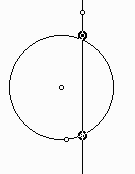Relations, Functions, and Function Notation
I. Homework
II. Definition of a Relation, Domain, and Range
Examples:
A) Consider the relation that sends a student to that student's age.
B) Consider the relation that sends a student to the courses that student is taking
C) Consider the relation that sends a parent to the parent's child.
Definition:
A relation is a correspondence between two sets (called the domain and the range) such that to each element of the domain, there is assigned one or more elements of the range.
Non-Example: Let the domain be the set of all LTCC students and the range be the set of all math course offerings at LTCC. Then the map that takes a student and sends the student to the math course he or she is taking is not a relation since there are students who are not taking math courses.
To state a relation, one must state the domain and the range and the rule.
Example:
(2,3), (2,4), (3,7), and (5,2) is a relation with
Domain: {2,3,5} and
Range: {2,3,4,7}
A circle represents the graph of a relation.
III. Functions
Definition:
A function is a correspondence between two sets (called the domain and the range) such that to each element of the domain, there is assigned exactly one element of the range.
(each input has a unique output)
Examples:
(3,3), (4,3), (2,1), (6,5) is a function with domain: {2,3,4,6} and range {1,3,5}
(2,1), (5,6), (2,3), (6,7) is not a function since 2 gets sent to more than one place.
IV. The Vertical Line Test
If any vertical line passes through a graph at more than one point, then the graph is not the graph of a function. Otherwise it is the graph of a function.
Examples:
A circle is not the graph of a function

A (non-vertical) line is the graph of a function.
Other examples will be given in class.
V. Function notation
We write f(x) to mean the function whose input is x.
Examples:
If f(x) = 2x-3
then f(4) = 2(4) - 3 = 5
We can think of f and the function that takes the input multiplies it by 2 and subtracts 3. Sometimes it is convenient to write f(x) without the x. Thus:
f( ) = 2( ) - 3
whatever is in the parentheses, we put inside. For example:
f(x - 1) = 2(x - 1) - 3
(f(x + 4) - f(x))/4 = ([2(x + 4) - 3] - [2(x) - 3]/4 = (2x + 8 - 3 - 2x + 3)/4 = 8/4 = 2
We will try other examples.
VI. Function Arithmetic
We define the sum, difference, product and quotient of functions in the obvious way.
Example:
If f(x) = (x + 1)/(x - 1) and g(x) = x2 + 4
then
(f + g)(x) = (x + 1)/(x - 1) + (x2 + 4)
(f - g)(x) = (x + 1)/(x - 1) - (x2 + 4)
(f g)(x) = [(x + 1)/(x - 1)][(x2 + 4)]
(f /g)(x) = [(x + 1)/(x - 1) ]/ (x2 + 4)